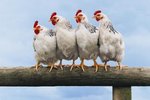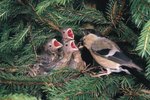
The peacock’s train, often incorrectly called the tail, makes a stunning display when he lifts it to show off the colors and its many eyespots to a potential mate. It’s possible to breed your peacock so that you have more of these striking birds to keep or to sell. The peacock -- the male peafowl -- will need up to five peahens to live with, and a safe place to nest, before you’ll have any peachicks running around.
Space
Each bird should have a minimum of 100 square feet of floor or ground space within the nesting area. Peacock trains can be 5 feet long and at least 5 feet high when displayed, so a peafowl nesting area must take this into account. Plan on making the pen at least 10 feet wide and 6 feet high to accommodate a male. Locate the pen in an area away from distractions and hazards to help the nesting birds feel safe.
Fencing
The nesting area must be fenced to exclude predators. Set sturdy wooden posts every 8 to 12 feet around the perimeter of the pen. Use a fence-stretcher to pull the hardware cloth or chicken wire tight. The holes have to be small enough to keep young peachicks in. Nail the fence to the posts with fence staples. Bury the bottom of the wire at least 6 inches deep and turn the buried part outward to discourage dogs and other pests from pushing or digging their way in under the fence. Cover the top tightly to keep out owls and hawks.
Nest
To make a nest, use a saw to cut a 55-gallon plastic drum down to about a third of its original height. Weight the bottom with some bricks, or nail it directly to the wooden floor of the shelter, to keep it from tipping. Make a next box by nailing two 1-by-8 boards across a corner of the shelter to create a 16-inch-high wall. Fill the nest about two-thirds full with straw or wood shavings. Peahens will often share a nest, so one or two nests is usually adequate for several peahens.
Housing
A simple structure that provides shelter from wind, rain and cold is important for nesting peafowl. An existing or prefabricated shed works fine as a shelter, or use plywood or a similar material to make three sides and a roof. Use 2-by-4 boards to make roosts, with the wide side facing up. Place the boards 3 to 6 feet off the ground, depending on the height of your shelter. Fasten the roosts securely at both ends.
Other Considerations
Place food and water dishes where the birds can easily access them, but never under roosts or other perches where they may get feces in them. Check out the nesting area carefully before the birds move in. Remove all obvious hazards such as broken glass and sharp metal objects. Also get rid of strings, which can wrap around their legs, and bits of hardware that the birds might swallow. Leave grass, bushes and other plants for them to peck at and scratch under and around.
References
- United Peafowl Association: Peafowl Nesting Boxes
- San Diego Zoo Animals: Birds: Peafowl
- The University of Western Australia: Peacock Information Sheet
- Avian Web: Peafowl
- Browfarm Peafowl: Peafowl Care Tips
- Oklahoma State University Cooperative Extension Service: Predators: Thieves in the Night
- United Peafowl Association: Heated Roost for Peafowl
- United Peafowl Association: Strings, Hog Rings and Other Dangerous Things
- Amy’s Peacock Paradise: Tips for building Peacock Pens
Photo Credits
-
Comstock/Comstock/Getty Images




